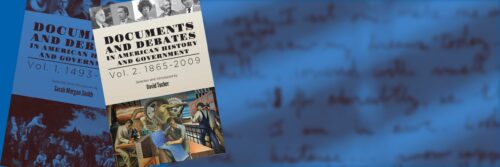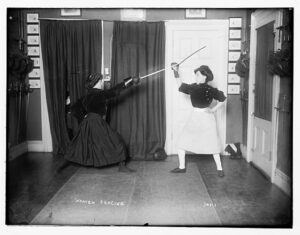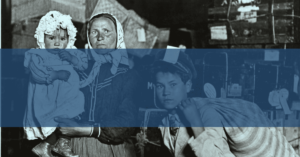
Did American Imperialism Threaten American Values?
Today we continue our exploration of Teaching American History’s two-volume document collection, Documents and Debates in American History and Government.
On September 6, 1901, President William McKinley was on the final day of a two-day visit to the Pan-American Exposition in Buffalo, NY. Before entering the Temple of Music for his last appearance at the Exposition, the gregarious McKinley paused to greet and shake hands with fellow fairgoers. A 28-year-old former steelworker and avowed anarchist, Leon Czolgosz, approached the President, drew a pistol, and fired two shots into McKinley’s abdomen. Bystanders and security personnel subdued Czolgosz, beating him nearly senseless, while others transported the President to the Exposition’s hospital, where he underwent emergency surgery.
For several days, it appeared that McKinley would recover from his wounds. The nation was so optimistic about his chances that even his Vice President, the pugnacious Theodore Roosevelt, went hiking, confident he would not be called upon to assume the presidency. Unfortunately, gangrene developed in the President’s wound, and he succumbed to blood poisoning in the early morning hours of September 14, 1901.
McKinley confidant and ally Senator Mark Hanna of Ohio, who had engineered McKinley’s successful 1896 presidential campaign, was not a fan of Roosevelt. However, to silence Roosevelt politically, Hanna had reluctantly agreed to place Roosevelt on the Republican ticket in 1900. When he received the news of McKinley’s passing, Hanna exclaimed, “Now look, that damned cowboy is President of the United States.”
Nevertheless, Roosevelt’s rugged cowboy image resonated with many Americans. In hindsight, Roosevelt personified the nation in 1901. The youngest person ever to become the nation’s chief executive, Roosevelt assumed the mantle at the dawn of a new century. America had only recently begun to flex its industrial might in the Spanish-American War. The United States’ triumph over Spain led to its annexation of the Philippines and acquisition of Puerto Rico, spreading American military power across the globe. America was young, vigorous, and ambitious, just like its new President. Roosevelt embraced America’s burgeoning power, envisioning an aggressive domestic and foreign policy, executed from the Oval Office with a hands-on, sleeves-rolled-up approach.
A vigorous debate over the Philippines’ annexation preceded Roosevelt’s rise to the presidency. However, by the time he became President, imperialists like Senator Albert Beveridge (R–IN) and Roosevelt had prevailed. America was a new imperial power (in addition to Puerto Rico and the Philippines, the US had annexed Hawaii in 1898), eager to compete with Europe’s imperialist nations. Historian Robert H Wiebe argues in his book, The Search for Order: 1877-1920 that American progressives saw the world divided into two classes of countries; one comprised of civilized nations, chiefly America and Europe; the other, nations in Asia, Africa, and Latin America that Americans considered uncivilized if not barbaric. Moreover, American progressives believed Europe was aging and declining while the United States was young and rising. They wanted to take advantage of their new-found status to compete for global power and profits.
In Chapter 20, Progressive Foreign Policy: The Philippines from our Documents and Debates, two-volume collection, Teaching American History highlights the debate over the annexation of the Philippines. Anti-imperialists such as Henry Van Dyke argued that annexation was a violation of the American principles of equality and consent of the governed, as best articulated in the Declaration of Independence. Progressive Senator Albert Beveridge of Indiana responded that “The Declaration of Independence applies only to people capable of self-government. . . .” Beveridge argued that the Filipinos were not yet capable of that noble goal.
At Teaching American History, we believe students best understand history when they are encouraged to dive into the primary sources, reading the words written by the authors of the time and putting their questions to those authors themselves. In this way, students reach their own conclusions about the choices made by Americans of the past. We encourage you to engage your students in a close reading of these documents, as they record the questions Americans asked each other as they contemplated taking a role among the world’s imperial powers.
Documents in this chapter include:
- Henry Van Dyke, “The American Birthright and the Philippine Pottage,” November 24, 1898
- Senator Albert J. Beveridge (R-IN), Speech in the Senate in Support of an American Empire, January 9, 1900
We have also provided audio recordings of the chapter’s Introduction, Documents, and Study Questions. These recordings support literacy development for struggling readers and the comprehension of challenging text for all students.
Teaching American History’s We the Teachers blog will feature Documents and Debates with their accompanying audio recordings each month until recordings of all 29 chapters are complete. In today’s post, we feature Volume II, Chapter 20: Progressive Foreign Policy: The Philippines. On October 27, we will highlight Chapter 6: Revolutionary Considerations of Citizenship and Self-Government from Volume II of Documents and Debates in American History. We invite you to closely follow this blog so you will be able to take advantage of this new feature as the recordings become available.



